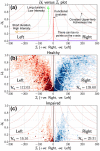A Framework for Sensor-Based Assessment of Upper-Limb Functioning in Hemiparesis
- PMID: 34366809
- PMCID: PMC8341809
- DOI: 10.3389/fnhum.2021.667509
A Framework for Sensor-Based Assessment of Upper-Limb Functioning in Hemiparesis
Abstract
The ultimate goal of any upper-limb neurorehabilitation procedure is to improve upper-limb functioning in daily life. While clinic-based assessments provide an assessment of what a patient can do, they do not completely reflect what a patient does in his/her daily life. The use of compensatory strategies such as the use of the less affected upper-limb or excessive use of trunk in daily life is a common behavioral pattern seen in patients with hemiparesis. To this end, there has been an increasing interest in the use of wearable sensors to objectively assess upper-limb functioning. This paper presents a framework for assessing upper-limb functioning using sensors by providing: (a) a set of definitions of important constructs associated with upper-limb functioning; (b) different visualization methods for evaluating upper-limb functioning; and (c) two new measures for quantifying how much an upper-limb is used and the relative bias in their use. The demonstration of some of these components is presented using data collected from inertial measurement units from a previous study. The proposed framework can help guide the future technical and clinical work in this area to realize valid, objective, and robust tools for assessing upper-limb functioning. This will in turn drive the refinement and standardization of the assessment of upper-limb functioning.
Keywords: arm and hand use; framework; hemiparesis; real world activity; sensorimotor assessment; stroke rehabilitation; upper-limb rehabilitation; wearable sensors.
Copyright © 2021 David, Subash, Varadhan, Melendez-Calderon and Balasubramanian.
Conflict of interest statement
The authors declare that the research was conducted in the absence of any commercial or financial relationships that could be construed as a potential conflict of interest.
Figures










Similar articles
-
Comparing algorithms for assessing upper limb use with inertial measurement units.Front Physiol. 2022 Dec 19;13:1023589. doi: 10.3389/fphys.2022.1023589. eCollection 2022. Front Physiol. 2022. PMID: 36601345 Free PMC article.
-
Upper limb movement profiles during spontaneous motion in acute stroke.Physiol Meas. 2021 May 11;42(4). doi: 10.1088/1361-6579/abf01e. Physiol Meas. 2021. PMID: 33735840
-
Construction of efficacious gait and upper limb functional interventions based on brain plasticity evidence and model-based measures for stroke patients.ScientificWorldJournal. 2007 Dec 20;7:2031-45. doi: 10.1100/tsw.2007.299. ScientificWorldJournal. 2007. PMID: 18167618 Free PMC article.
-
Assessment of upper limb use in children with typical development and neurodevelopmental disorders by inertial sensors: a systematic review.J Neuroeng Rehabil. 2018 Nov 6;15(1):94. doi: 10.1186/s12984-018-0447-y. J Neuroeng Rehabil. 2018. PMID: 30400992 Free PMC article.
-
Task selection for a sensor-based, wearable, upper limb training device for stroke survivors: a multi-stage approach.Disabil Rehabil. 2023 May;45(9):1480-1487. doi: 10.1080/09638288.2022.2065542. Epub 2022 Apr 27. Disabil Rehabil. 2023. PMID: 35476616 Review.
Cited by
-
Comparing algorithms for assessing upper limb use with inertial measurement units.Front Physiol. 2022 Dec 19;13:1023589. doi: 10.3389/fphys.2022.1023589. eCollection 2022. Front Physiol. 2022. PMID: 36601345 Free PMC article.
-
A data-driven approach to detect upper limb functional use during daily life in breast cancer survivors using wrist-worn sensors.Sci Rep. 2024 Aug 6;14(1):18165. doi: 10.1038/s41598-024-67497-6. Sci Rep. 2024. PMID: 39107354 Free PMC article.
-
Classification of functional and non-functional arm use by inertial measurement units in individuals with upper limb impairment after stroke.Front Physiol. 2022 Sep 28;13:952757. doi: 10.3389/fphys.2022.952757. eCollection 2022. Front Physiol. 2022. PMID: 36246133 Free PMC article.
-
Computer-assisted approaches for measuring, segmenting, and analyzing functional upper extremity movement: a narrative review of the current state, limitations, and future directions.Front Rehabil Sci. 2023 Apr 11;4:1130847. doi: 10.3389/fresc.2023.1130847. eCollection 2023. Front Rehabil Sci. 2023. PMID: 37113748 Free PMC article. Review.
-
Trends and Innovations in Wearable Technology for Motor Rehabilitation, Prediction, and Monitoring: A Comprehensive Review.Sensors (Basel). 2024 Dec 13;24(24):7973. doi: 10.3390/s24247973. Sensors (Basel). 2024. PMID: 39771710 Free PMC article. Review.
References
LinkOut - more resources
Full Text Sources

